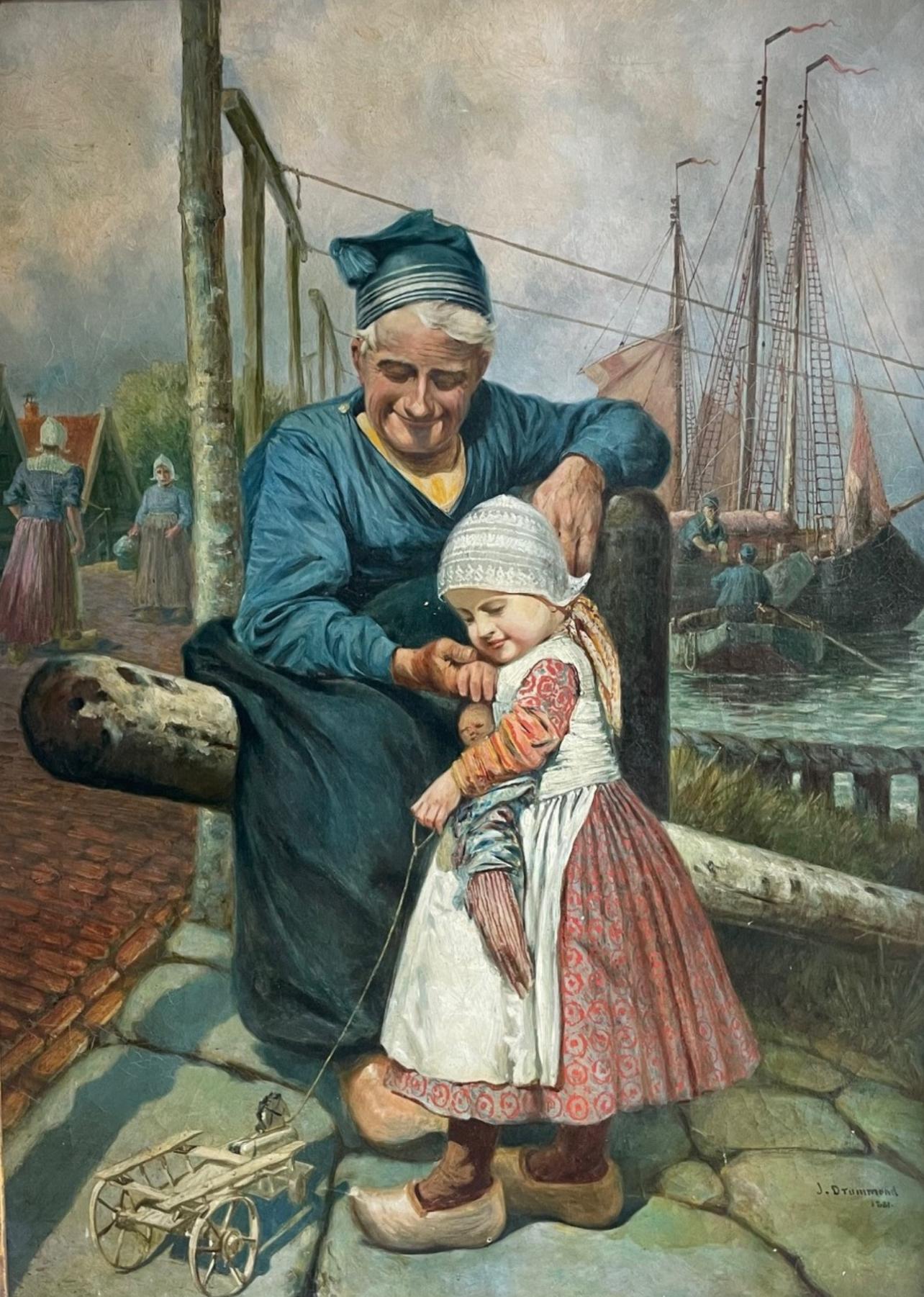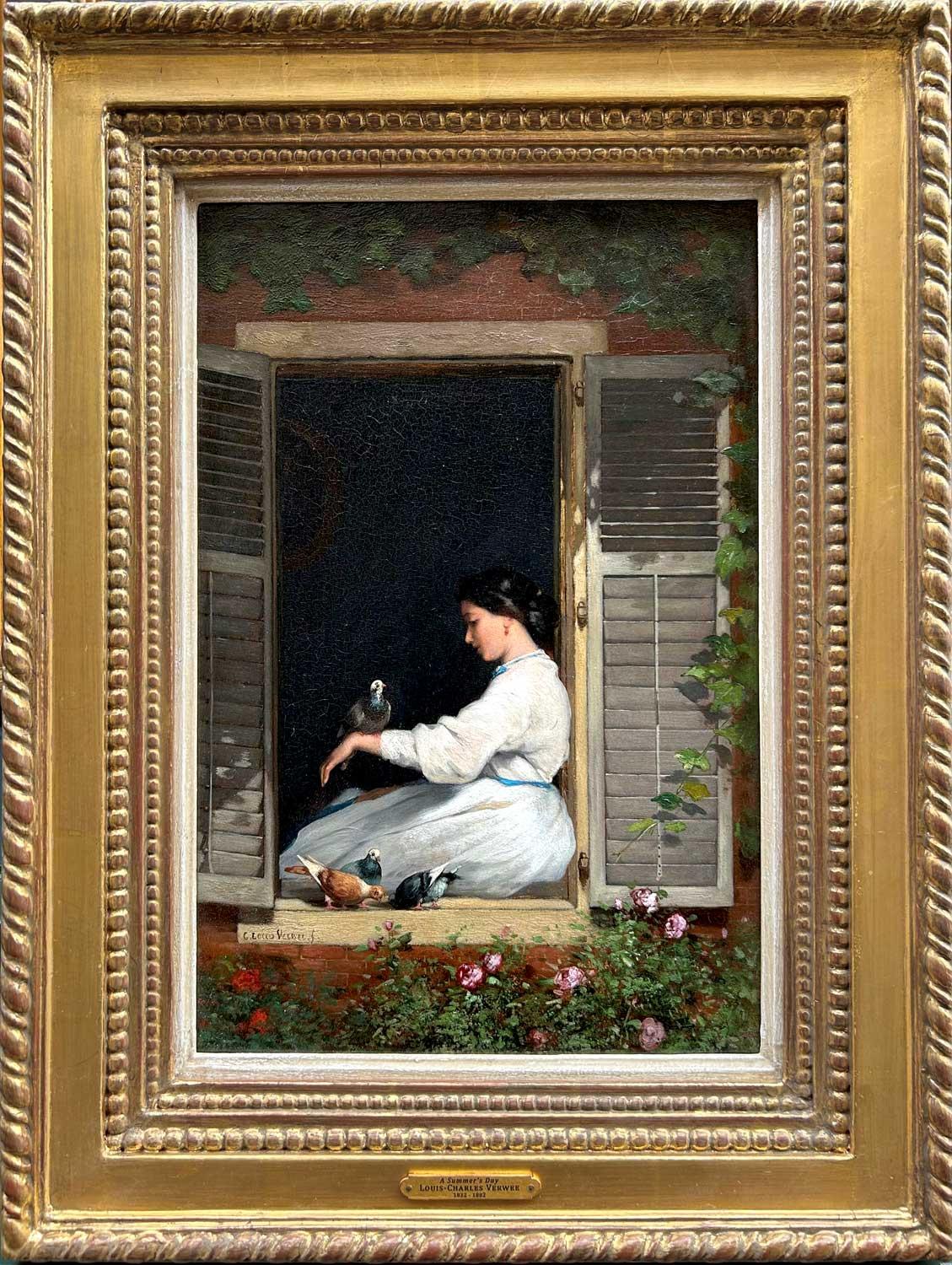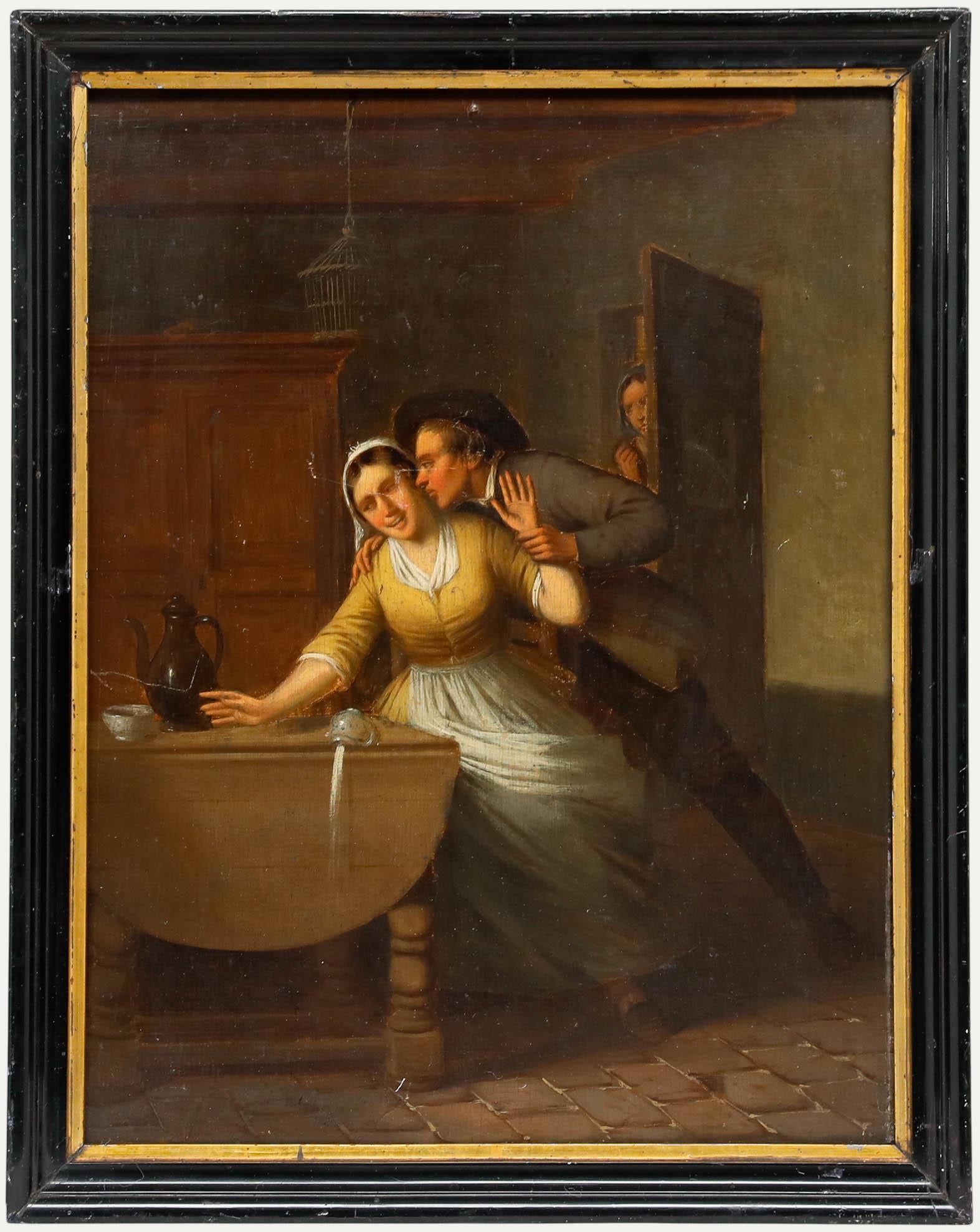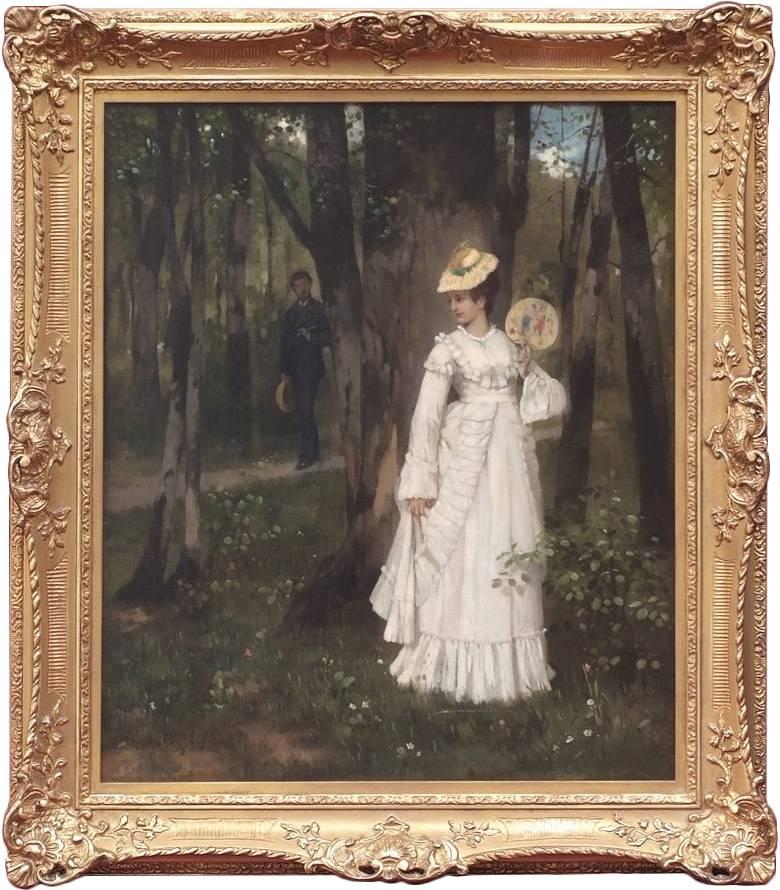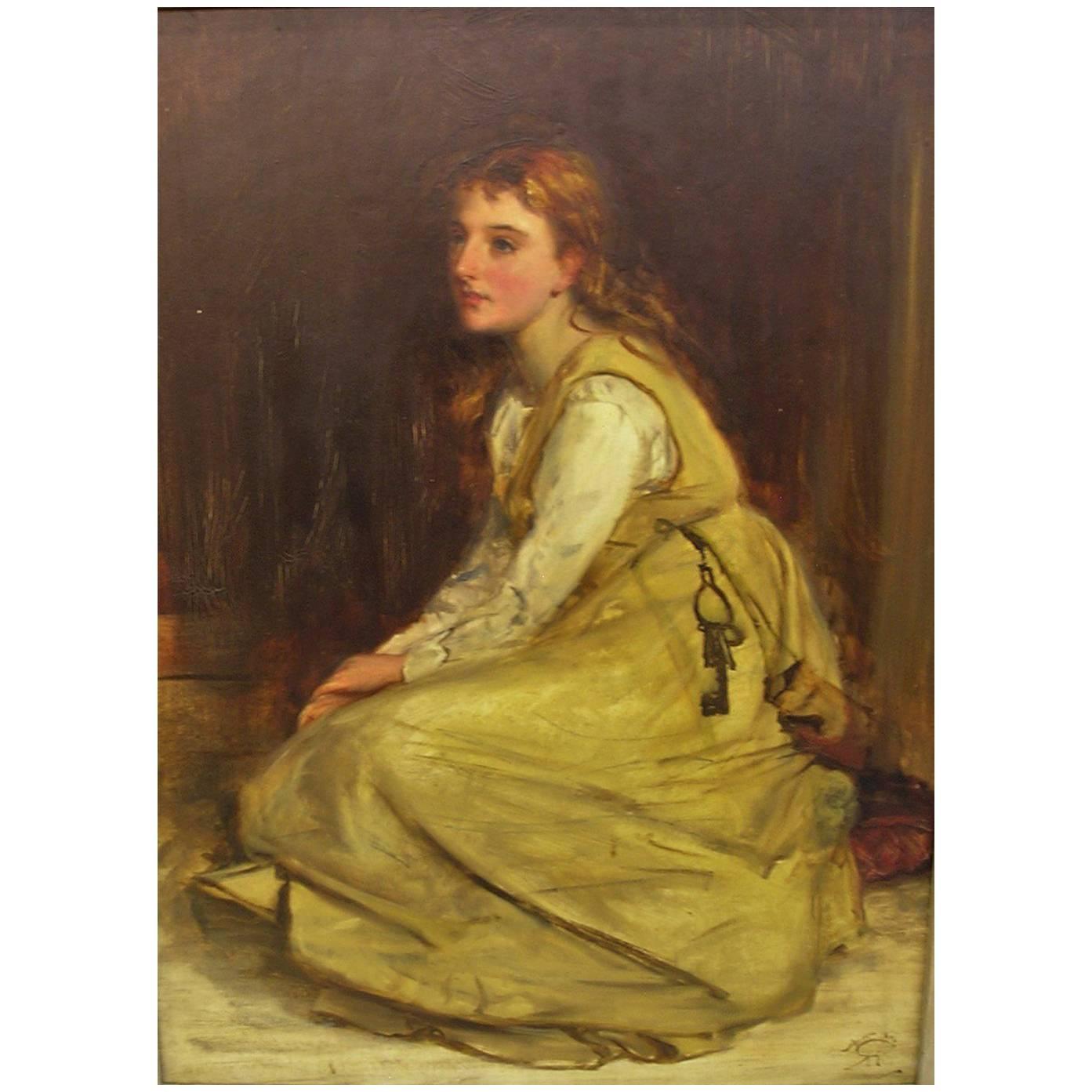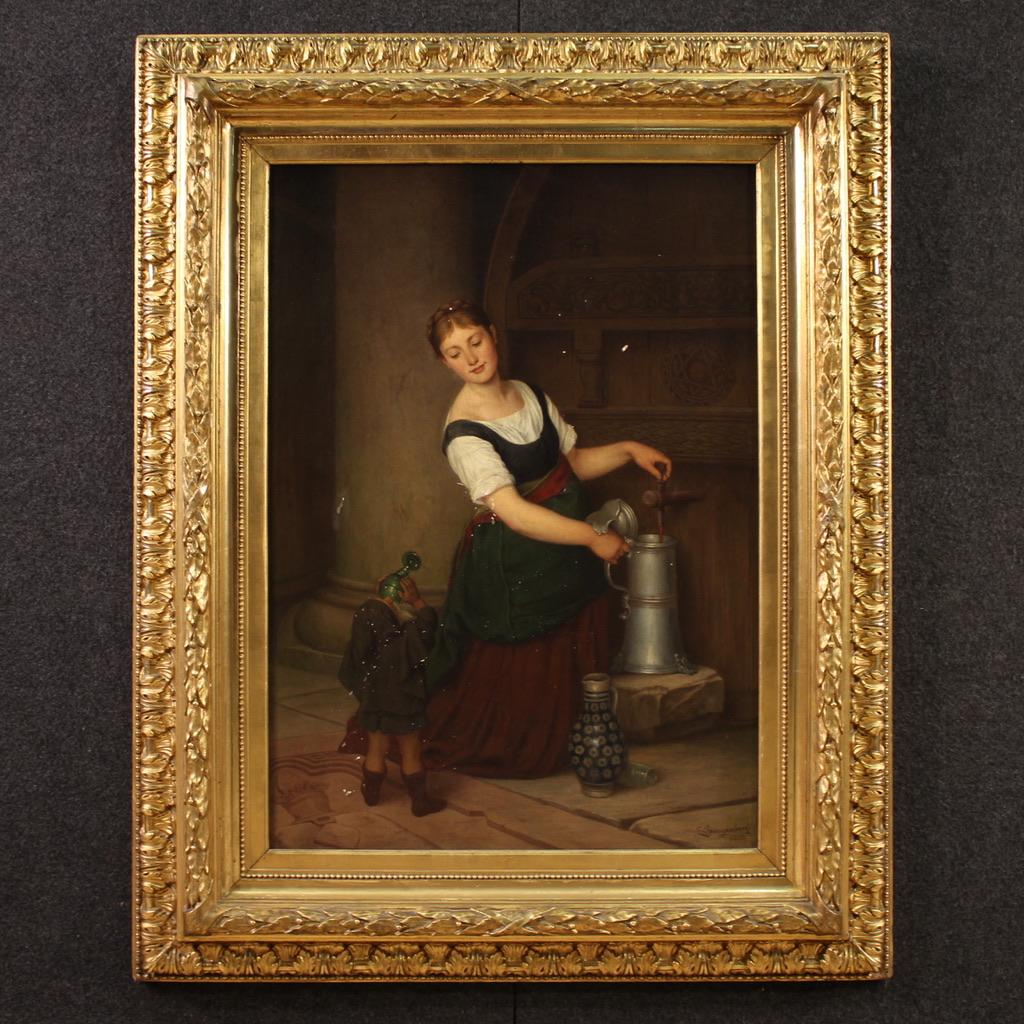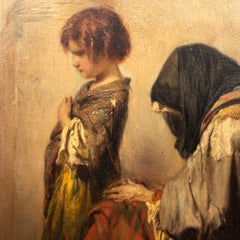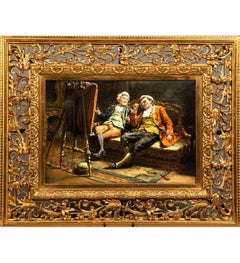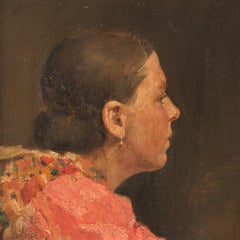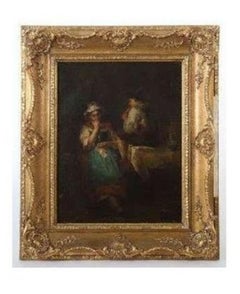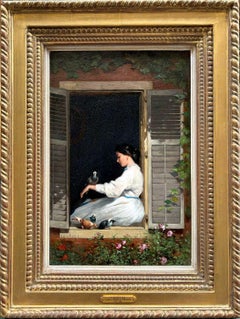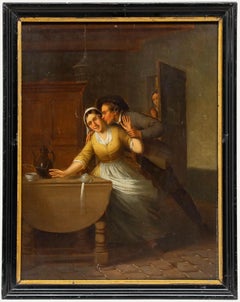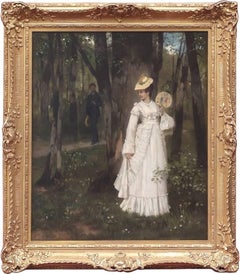Items Similar to Charles Louis Verwee (1832-1882) A Possible Purchase
Want more images or videos?
Request additional images or videos from the seller
1 of 15
Charles Louis Verwee Charles Louis Verwee (1832-1882) A Possible Purchase19th century
19th century
$35,671.40
£26,756.30
€30,000
CA$49,797.03
A$53,936.16
CHF 28,566.98
MX$652,546.79
NOK 359,131.16
SEK 334,786.57
DKK 228,534.77
About the Item
The painting "A Possible Purchase" by Charles Louis Verwee, a renowned Belgian artist, captures a delicate and poignant moment. In this piece, a woman is depicted standing in an opulent interior, absorbed in contemplation as she examines a framed portrait of a young girl. Her elegant attire, composed of a refined beige dress, contrasts beautifully with the rich red upholstery of the furniture. The scene is meticulously detailed, with objects such as a fringed shawl draped over a chair, decorative plates, and oriental fans adorning the walls, all contributing to the intimate and luxurious atmosphere.
Verwee's mastery of light and shadow is evident in the soft illumination that highlights the woman's face and dress, creating a gentle chiaroscuro effect. The composition is dynamic yet balanced, guiding the viewer’s eye from the woman’s thoughtful expression to the framed portrait, and around the richly decorated room.
Provenance of the Painting
"A Possible Purchase" has an interesting provenance, having been part of several prestigious collections. It was previously owned by Eugene Iglesias of Hollywood, California, and before that, it was acquired from Anderson Galleries in Beverly Hills. The painting was also listed at a Butterfields auction in Los Angeles in 1999, further highlighting its journey through various esteemed hands. Currently, it is part of the collection of Chastelain & Butes.
Composition:
• Subject Placement: At the heart of this painting, a woman dressed in an elegant beige dress leans forward to closely examine a framed portrait on a chair. Her placement slightly off-center to the right enhances the scene's dynamic nature.
• Elements: The background is rich with decorative elements, including a red sofa, a wall adorned with various items like a plate and a fan, and a mirror reflecting part of the room. The foreground showcases the chair with the portrait and a fringed shawl draped over its back, adding texture and depth.
• Perspective: The perspective is intimate, drawing the viewer into the room and focusing on the woman’s interaction with the portrait. This creates a sense of personal engagement and curiosity about the relationship between the woman and the subject of the portrait.
Theme:
• Reflection and Memory: The act of the woman closely examining the portrait suggests themes of reflection and memory, indicating a moment of personal contemplation or nostalgia.
• Domesticity and Elegance: The setting, with its rich furnishings and detailed decor, conveys a sense of domestic comfort and elegance, highlighting the lifestyle and interior aesthetics of the period.
• Influence of Contemporary Artists: The intimate and anecdotal nature of the scene is reminiscent of the works of Alfred Stevens and Gustave Léonard De Jonghe, artists known for their detailed depictions of domestic life and nuanced portrayal of women's daily activities.
Use of Colors:
• Warm Tones: Dominated by warm, rich tones, the painting features the red of the sofa and brown hues of the woman's dress and the room’s wooden elements, creating a warm and inviting atmosphere.
• Contrast: The light-colored dress of the woman stands out against the darker background, drawing attention to her figure and her actions. The contrast between light and shadow adds depth and dimension to the scene.
• Subtle Highlights: Subtle highlights on the woman’s dress and face, as well as on the frame of the portrait and the decorative items, enhance the realism and add to the tactile quality of the various textures depicted.
Use of Light:
• Directional Light: The light source appears to come from the left, illuminating the woman and the items in the foreground, creating shadows that add to the sense of depth and three-dimensionality.
• Highlighting Focus: The lighting focuses on the woman and the portrait, emphasizing the interaction and drawing the viewer’s eye to this central narrative element. The use of light and shadow also accentuates the textures and details of the furnishings and decor.
• Atmospheric Effect: The overall lighting is warm and soft, contributing to an intimate and contemplative atmosphere. The reflections and subtle play of light and shadow evoke a sense of quiet elegance and introspection.
Additional Details:
• Textural Elements: The detailed rendering of the woman’s dress, the fringed shawl, and the upholstered furniture adds richness and a tactile quality to the painting, enhancing the sense of realism and immersion in the scene.
• Decorative Background: The decorated wall with various items, including a plate and a fan, adds cultural and historical context, suggesting the taste and interests of the household. The mirror also serves to expand the space visually and adds complexity to the composition.
Context and Biography
Context and Biography of Charles Louis Verwee (1832-1882)
Charles Louis Verwee (1832-1882) was a notable Belgian painter, best known for his genre scenes and portraits. Born in Brussels, he was the son of Louis-Pierre Verwee, a celebrated landscape and animal painter, and the brother of Alfred Jacques Verwee, whose works are displayed at the Royal Museums of Fine Arts of Belgium. This artistic environment profoundly influenced his development as a painter.
Initially trained by his father, Verwee later studied under prominent artists like Alfred Stevens and Gustave Léonard De Jonghe, which helped him refine his style. He participated in numerous art exhibitions, including the Brussels Salon in 1854, the Antwerp Salon in 1861, and later exhibitions in Ghent and Amsterdam.
Verwee's work often depicted scenes of domestic life and intimate moments, characterized by their anecdotal nature and fine attention to detail. His ability to capture the essence of his subjects with a sense of realism and emotional depth set him apart from his contemporaries. Notable works include "The Connoisseur in the Artist’s Studio with his Dog," which showcases his keen observation skills and ability to infuse everyday scenes with narrative richness.
Verwee's paintings gained considerable acclaim during his lifetime, attracting the attention of notable collectors, including King Leopold II of Belgium. His work "Diplomacy," which depicts a lower-class character, is part of the royal collection, underscoring his versatility and appeal across different social strata.
Verwee passed away in Saint-Josse-ten-Noode in 1882, leaving behind a legacy of beautifully rendered scenes that capture the elegance and intricacies of 19th-century Belgian society.
- Creator:Charles Louis Verwee (1832 - 1882, Belgian)
- Creation Year:19th century
- Dimensions:Height: 38.58 in (98 cm)Width: 30.71 in (78.01 cm)Depth: 2.76 in (7.02 cm)
- Medium:
- Period:
- Condition:
- Gallery Location:Gent, BE
- Reference Number:1stDibs: LU2140214973462
About the Seller
5.0
Vetted Professional Seller
Every seller passes strict standards for authenticity and reliability
Established in 2018
1stDibs seller since 2022
6 sales on 1stDibs
Typical response time: 6 hours
- ShippingRetrieving quote...Shipping from: Gent, Belgium
- Return Policy
More From This Seller
View AllAlone in the world, Oil on panel by Duwez Henri-Joseph (1810-1884)
Located in Gent, VOV
Alone in the world
Signature on the left
Presented in a period frame
Provenance: Sold in Paris on February 6, 1895, at Drouot, for 140 Gold Francs (Bénézit)
Biography Henri-Joseph ...
Category
19th Century Academic Figurative Paintings
Materials
Acrylic
Léon BRUNIN (1861 - 1949)+Oil on panel, Art collectors
Located in Gent, VOV
Les collectionneurs d'art, Oil on panel by Léon BRUNIN (1861 - 1949)
Léon Brunin's subjects are always meticulously painted, with abundant reproduction of detail and as many shades ...
Category
Late 19th Century Realist Figurative Paintings
Materials
Oil
Demetrio COSOLA (1851 – 1895) Portrait of a woman Oil on canvas
Located in Gent, VOV
Cosola Demetrio (1851-1895)
Demetrio Cosola lived his entire short life between Chivasso and Turin. At the age of eighteen he entered the Accademia Albertina in Turin, where he becam...
Category
19th Century Portrait Paintings
Materials
Canvas, Oil
Kurzbauer Eduard (1840 - 1879)+ Oil on canvas The Serenade
Located in Gent, VOV
Eduard Kurzbauer's enchanting “La Sérénade” transports us to the heart of an intimate 19th-century interior. In this oil painting, a woman engrossed in her needlework is interrupted ...
Category
Late 19th Century Realist Interior Paintings
Materials
Oil
Original oil on canvas by Trumphème Auguste (1836-1898), Held back
Located in Gent, VOV
This original oil on canvas by Auguste Trumphème, titled "Held Back," is a stunning example of the artist's realist style. Painted in the 19th century, this artwork depicts a captiva...
Category
Late 19th Century Realist Figurative Paintings
Materials
Oil
The Beauty of Becoming Oil on canvas by Francesco Longo Mancini
Located in Gent, VOV
She sits at the threshold of transformation.
A young woman, caught in the quiet exultation before her first ball, smiles—not to anyone in particular, but to herself, and to the momen...
Category
20th Century Academic Portrait Paintings
Materials
Oil
You May Also Like
Sans titre (1881), James Drummond, R.S.A., F.S.A.
Located in Fairfield, CT
Artist: James Drummond, R.S.A., F.S.A. (1816-1877)
Title: Sans titre (1881)
Year: 1881
Medium: Oil on canvas
Size: 37 x 29 inches
Inscription: Hand signed and dated, recto
Provenance...
Category
1880s Academic Figurative Paintings
Materials
Oil
$39,996 Sale Price
20% Off
A Summer's Day
Located in London, GB
Louis-Charles Verwee
A Summer's Day
1832-1882
Oil on panel, signed lower left
Image size: 14 1/4 x 9 3/4 inches
Contemporary style giltwood frame
The subject matter of this painting...
Category
19th Century Figurative Paintings
Materials
Oil, Board
C. H. Renneman - 1867 Oil, Unwanted Attention
Located in Corsham, GB
A striking genre scene depicting a man trying to embrace a woman in a dimly lit interior. The woman attempts to push him away as a bystander watches the scene unfold from the doorway...
Category
Mid-19th Century Figurative Paintings
Materials
Oil
Painting 19th century Genre Scene Landscape With Characters
By Eduard Niczky
Located in Saint-Ouen, FR
Niczky Edouard (1850 – 1919)
Love date in 19th century
Oil on canvas signed low left
Old original frame gilded with leaves
Dim canvas : 61 X 52 cm
Dim frame : 76 X 66 cm
Certificate of authenticity
Niczky Eduard (1850 – 1919)
German painter 19th century
Birth on July 17th, 1850 in Kassel
Died on May 16th, 1919 in Munich
Painter of genre scenes, portraitist, landscapes and flowers.
Eduard Niczky...
Category
1880s Post-Impressionist Portrait Paintings
Materials
Oil
Robert Herdman Painting
By Robert Herdman
Located in Hamilton, Ontario
Robert Herdman (Scottish 1829-1888) oil on board.
Nicely framed by Robert Herdman depicting woman sitting with keys.
Measures: Size without frame 17.5" wide X 23.5" high
Size with...
Category
Antique Mid-19th Century Scottish Victorian Paintings
Materials
Paint
$14,500
19th Century Oil on Canvas Signed G. Spangerberg Interior Scene Painting, 1886
Located in Vicoforte, IT
A refined 19th-century interior scene. Oil on canvas, first canvas, painting signed G. Spangerberg lower right and dated 1886, attributed to the German painter Gustav Adolf Spangenbe...
Category
1880s Figurative Paintings
Materials
Canvas, Oil
More Ways To Browse
Antique Dress Stand
Oriental Plate
Fringe Chair
Fan Mirror
Antique Wall Fan
Antique Red Sofa
19th Century Painting Girl With Dog
De Jonghe
Painting Of Sofa
Antique Oriental Fans
Gustave De Jonghe
Oil Painting General
Old Master Copies Painting
Peter Max Mixed Media Umbrella Man
Prince Oil Painting
Pulp Painting
Puppets Paintings
Rites Of Spring
